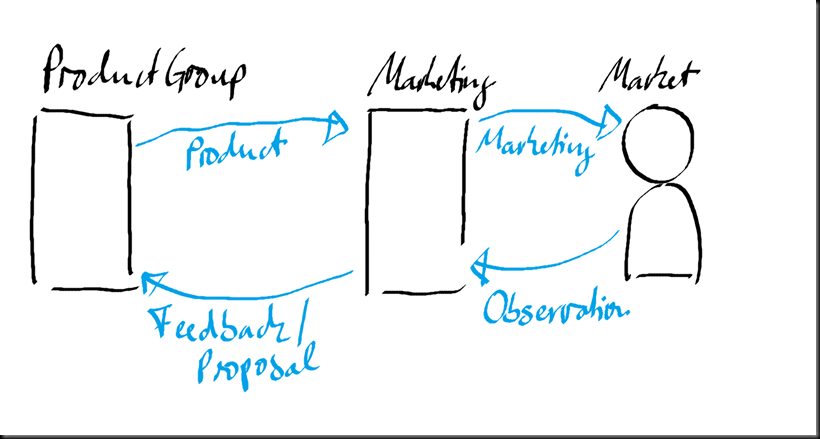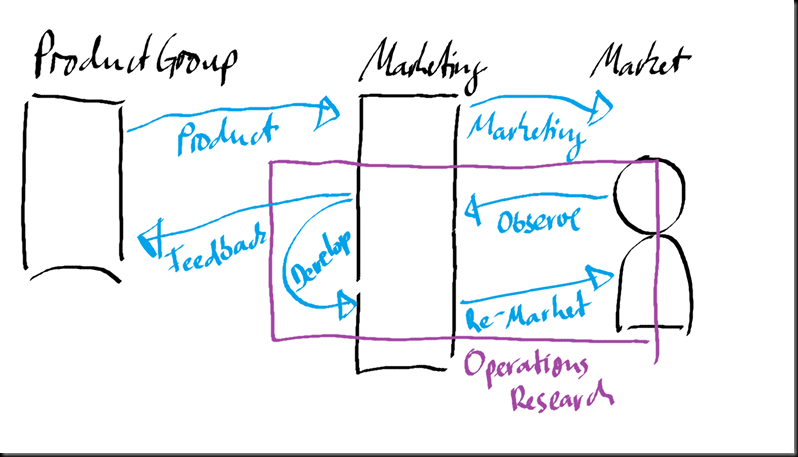New Role of Marketing and Operation Research
Hi…
this time I’d like to combine several thoughts and observations I made recently. It is all about the new marketing and operation research. In a way, it leads to two ways of innovation necessary to escape the Innovator’s Dilemma. Keep in mind that I reflect on the IT industry. But let’s start at the beginning.
Classical Marketing and Product Innvoations
The graph above shows – in a simplified way – how marketing and production (or the product groups) interacts. As you can see there are three main players: The market itself, marketing and the product group.
Today – in the best case – marketing is involved into observing the market and gives feedback or even proposes new products to the product groups. The groups specify, develop, test and release a product. A process which might take years to end and results in a product handed back to marketing. Now it is the intention of marketing to brings this to market by advertizing. I will call this the classical flow and it is highly outdated!!
- Involving Marketing into product specification is not a given! For product groups as the secret place of innovation it is hard to accept external guidance. And in fact it is a delicate balance to keep. I read once that Ford once said that if he had asked his customer about their wishes, they problably would have answered faster horse carriages. Innovation goes beyond the obvious, marketing most likely sees the obvious.
- Quality of Marketing Staff: Even beside the fact that marketing organisations should be the parts of a company that knows there market, its needs and possible desires best, this is not always the case. Marketing organizations tend to loose empathy for their audiences because business management (a.k.a. running Excel reports) is higher valued than empathy.
- The turn around of the cycle is to slow! The last but the most sultry effect. In this classical setup, marketing gets a product which has been developed for years based on predictions done years ago. It now has the task to help sell the product by advertising it for years to come (until the next release).
There are specific hurdles that keep this system in place as it is:
- Necessary product development time: Quality, innovative products need their time to be developed and tested. Sometimes documented. The typical project triangle applies: Resources, features and timeline. You cannot shorten one without bending the other to infinity.
- History of marketing: Looking on the history of marketing, marketeers see themselves as the pioneers to build roads and bridges for the sales force directly behind them. They are good in communicating product aspects but not trained in defining those. Adopting products to new markets is done as long the product itself does not need to be bend in any way. While this leaves out parts of the market, it is certainly the most secure way of living.
- Intellectual properties: Managing IP is no easy task at all. There are two sides to it. First generating new IP that is worth to be protected needs to be secured very early in the process. If the idea is out there, everybody else will use (maybe even faster than its originator) or – even worse – somebody else protects it and forces the originator to pay for his own idea. Secondly, making sure the IP used is licensed correctly is hard, too. Any fault here can be very costly.
Marketing 2.0 – Light Edition and Professional Version
Now everybody is talking about Marketing 2.0. For me in fact that is at least Marketing 3.0. Starting in the beginning of the last century, marketing was all about advertising facts. Markets were not saturated and any product build was sure to be sold. This changed after WWII, in saturated markets marketing – still all about advertising – started to hammer perceived product advantages into the brain of the customer. But products got more and more equal to each other and the features advertized got more and more esotherical. In the end, smiling young families ran over greens in front of their brilliant homes to advertise washing powder or natural gas. Today, everybody has learned to actively ignore advertisements. Today, ads need to shock (see the recent French anti-smocking campaign) otherwise they drawn. Today, the new marketing is about providing values (and make them known). So, marketing starts to be more active. There is a change in channels but also a change in what proficiency marketeers need to have. Empathy is one of which.
So far, I would call this the light edition. The full version needs more. The full version does two things more:
- Actively seeking for “misusage”: Where is the product used in a way that is not supported? Why is this and how can we make it supported? For example, Microsoft equipped its Office suite with a pretty powerful macro recorder that based on Visual Basic. The idea was to enable small macros but in the end it was used to build mission critical apps with countless lines of business code in it. In the end, customers found that the platform is not equipped to carry this (source code management as an example) and Microsoft discovered that there is a need for such a platform.
- Actively search for obstacles: Why is the product not used in a certain arena like it could be? How can we bridge the last millimeters? For example, we were wondering why Windows Server has such a hard stand in the German web market and discovered that the lack of a rich and easy to install web application portfolio was missing. So we made a prototype, received very positive feedback…well, fast forward, it is called Web Platform Installer nowadays and you can find it on www.microsoft.com/web
There is still one thing left out: Actively seeking for voids. Is there a need in the market which is not addressed today?? Or a need that nobody is aware of as of today?? While marketing should play a major role in discovering those, most of the times this needs new products, disruptive innovation and in the end the product group.
Operation Research
I just recently fell over Operation Research. It caught my attention and still has. First, grab yourself the definition and some annecdotes here https://en.wikipedia.org/wiki/Operation_research
In a way, Operation Research (OR) has the idea to optimize a solution by using formal (a.k.a. mathematical) methods. To do so, one need to define a measurement for the current state first, than find possible improvements, try (by prototyping or by simulating) and judge them according to the measure. How far is this away from Industrial Design (https://en.wikipedia.org/wiki/Industrial_design)?? I leave this to the reader as a homework. For me, it is obvious that OR is not about the big leap of innovation (while there is still a chance to do that). Rather it is about small, innovative steps.
Thinking about OR, I asked myself who is doing OR in the software world today?? Well, I guess, in the majority of cases the power user does. And there is no difference between open source and closed source, sorry to say. Most of the times, they are not aware of doing so because we call it “community”. May I give an example? Well, when I started – a long time ago – to develop for a well-known database (NOT Microsoft SQL!!), I discovered that the tools provided were - politely said – not sufficient. I was not the first to discover that so some friendly power users made a tool called Toad which filled the gap. I wondered why the database producer itself did not provide something similar…
Sometimes our power users are not welcome and systems are closed due to business reasons. This is totally fair because our power user does not really do OR. Instead he is missing out one significant part: Quality assurance. Some of the solutions are of high quality but others aren’t. Giving away control means to open up for all kind of stuff and most of the times it falls back to the platform provider. Believe me, I am working for one…
OR must extend Marketing
The subject is my credo here. I do believe that modern marketing must embrace OR, so that the new layout looks like this:
Observation is still part of the marketing department but the results are differently. The observations made can lead to feedback and/or actions. Marketing asks a special, short time development unit to generate a prototype solution. The solution is re-marketed and reaction is measured. The measurement is part of the feedback to the product groups but now enriched with innovations.
What do you think??
CU
0xff

